The 2018 Apple iPad Pro (11-Inch) Review: Doubling Down On Performance
by Brett Howse & Andrei Frumusanu on December 4, 2018 10:00 AM ESTThe Liquid Retina Display
Apple offers some of the best displays on the market, and the iPad Pro is arguably their best display available. What Apple calls a Liquid Retina display is a 264 pixel-per-inch masterpiece. The 11-inch model we are reviewing holds a 2388x1668 7:5 aspect ratio panel, while the larger 12.9-inch model uses a 4:3 2732x2048 panel.
There’s a lot that sets Apple apart from other manufacturers on the market. The company has taken display accuracy seriously longer than anyone outside of the professional field. The display in the iPad Pro is also a P3 D65 gamut display, but thanks to the color management system that Apple moved over from the Mac, it simultaneous offers near-perfect sRGB reproduction as well as near-perfect P3 reproduction whenever an app or image specifically says it's P3. There’s no compromise on offering the P3, and no need to change the gamut on the display to match different color spaces. It’s a P3 display where sRGB is properly mapped.
In addition, Apple’s iPad Pro offers their ProMotion technology, which means it is a 120 Hz display, but one that supports variable refresh rates in order to lower the display's refresh rate for power management purposes. The iPad Pro will go as low as 24 Hz, presumably chosen to match the framerate of most movies. Apple also carries over its True Tone functionality, where ambient light sensors change the white point of the display to make it more suited to the environment it is in. It’s one of those features you never really knew you needed until you see it in action.
The fully laminated display also offers Apple’s industry leading antireflective coating, which Apple rates at 1.8% reflectivity, improving the results outdoors dramatically over most devices, and of course there is a fingerprint-resistant oleophobic coating as well.
Apple rates the latest iPads at up to 600 nits of brightness too, so pretty much no matter where you are, the combination of the high brightness and the antireflective coating should make for a great viewing experience.
To test the display characteristics, we turn to SpectraCal’s CalMAN software suite, along with an X-Rite i1Display Pro colorimeter for brightness and contrast readings, and the X-Rite i1Pro 2 spectrophotometer for color accuracy readings.
Brightness and Contrast
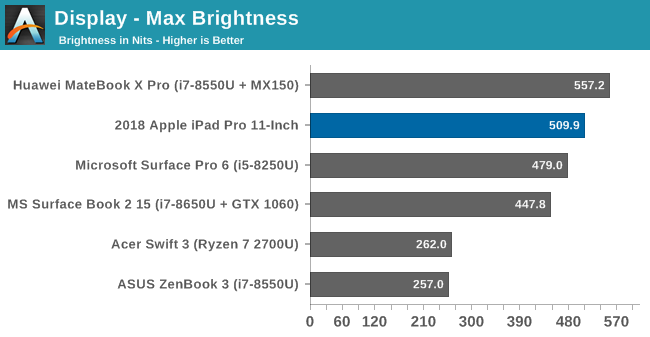
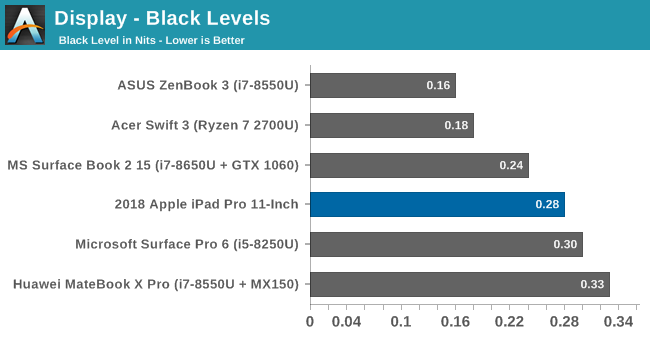
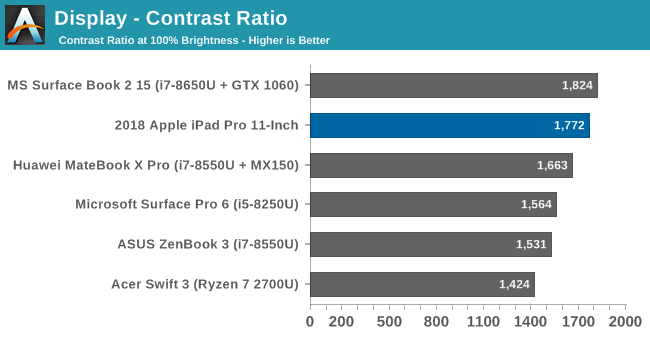
Under our test conditions the iPad Pro could not quite hit the 600 nits that Apple advertises, but at 500 nits it is still plenty bright. Couple that with the excellent contrast ratio of almost 1800:1, and things are off to a good start.
Grayscale
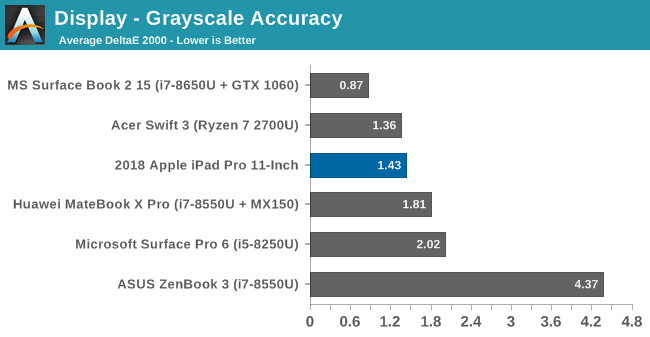
The average dE2000 of 1.43 is a fantastic result, but the gamma isn’t quite perfect, dropping off near 100% because the display was slightly too bright. Unfortunately, the red results were quite low throughout the entire range leading to a slightly cooler display white point, but this is all quite minor.
Gamut
First let’s take a look at sRGB:

As you can see, the sRGB values are almost perfectly mapped into the P3 D65 gamut, and the average error level of just over 1.09 is simply fantastic. All of the primary and secondary values are close to perfect, except red which was a bit low at 100% red, as we saw in the grayscale results.
Next up, P3 D65:
As with the sRGB results, the P3 D65 gamut is also almost perfect. The beauty of color management means that there’s no work for the user to get the benefit of both P3 and sRGB.
Saturation

The saturation sweep was run in sRGB, and as you can see from the graphs, all along all of the primary and secondary colors the error level is basically imperceptible to the human eye.
Gretag Macbeth
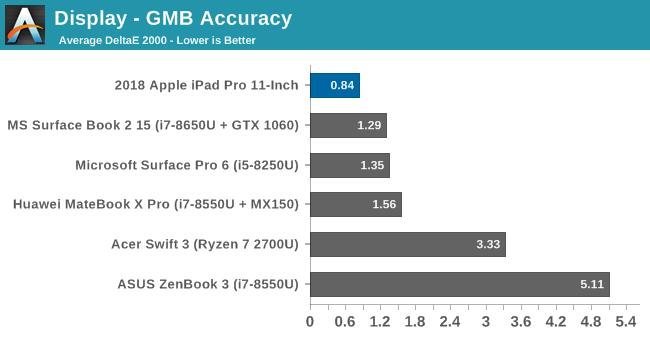
Finally, the Gretag Macbeth test is a more comprehensive test, hitting colors outside of the primary and secondary colors, including the important skin tones. The error level is practically perfect, with no single color even hitting an error level of 2.0.
Display Conclusion
The iPad Pro simply offers one of the best displays on any electronic device. Color accuracy is superb, in both the P3 and sRGB gamuts, and thanks to iOS supporting full color management, customers don’t have to worry about if they are working on a P3 or sRGB image. The addition of True Tone makes for an incredibly pleasing white point in pretty much any situation, and the 120 Hz display refresh rate makes for smooth scrolling, while stepping down to lower refresh rates to conserve power when the display is static.


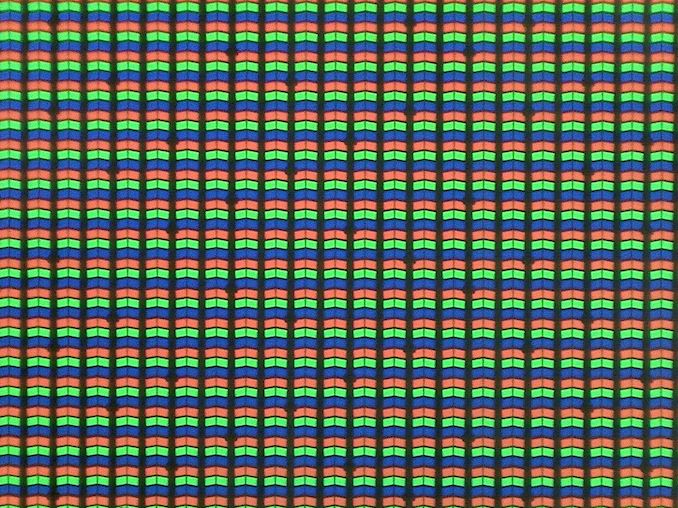


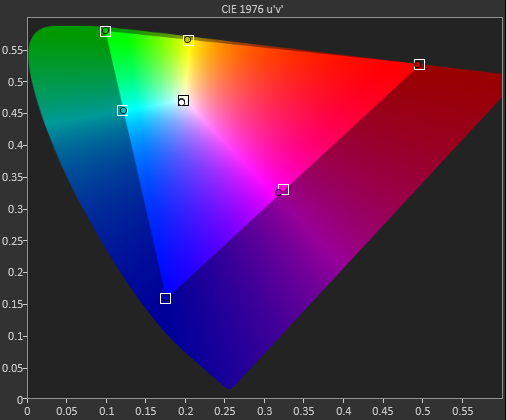










145 Comments
View All Comments
tipoo - Tuesday, December 4, 2018 - link
16nm did substantially cut its power use, and 16nm was less of a node leap than 7 (iirc it was closer to 22nm, but one of the finfett rebrandings?)Xbox One S 35-90
Xbox One 70-120
http://energyusecalculator.com/electricity_gamecon...
PeachNCream - Tuesday, December 4, 2018 - link
Yup, that is an impressively quick bit of hardware hiding inside the new iPad. It doesn't speak well for a lot of hardware that soaks up a bunch more power and needs a lot more cooling to accomplish similar task. I'm hoping the A12X will be something of a kick in the proverbial pants for the rest of the chip industry to get off their behinds and deliver better performance at much lower TDP, that is both CPU and GPU companies that are inflating real TDP to comparably absurd levels while chasing incremental and insignificant increases in performance.sing_electric - Tuesday, December 4, 2018 - link
To be fair, the A12 is one of the first 7nm chips to ship. AMD's Ryzen 2700U, in theory, is at least as powerful, but is built on a 12nm process so it consumes more power.A year from now, its very likely that AMD will have a mobile Ryzen built on the 7nm same process at the same foundry (TSMC) as Apple, which has the possibility of being more powerful at the same power consumption depending on workload (again, AMD and Apple optimize for different things in their chips, and an.... Apple to oranges comparison is hard to make).
Within a couple years, we'll see how Intel's new GPU unit does - they've committed to releasing dGPUs but you'd have to think that a side effect would be increased performance of their iGPUs as well. IF they're finally able to start mass-manufacturing on their 10nm (and future) process, they should be competitive as well.
Spunjji - Wednesday, December 5, 2018 - link
+1 to this. Very interested in what Intel can do at low TDPs given their experience there. UHD620 is an old architecture now, so you have to wonder what all the intervening development will grant their first real next-gen GPU.AMD have been struggling of late but it sounds like, if they coalesce their development around Navi, they should see some serious benefits at low TDPs too.
GruenSein - Tuesday, December 4, 2018 - link
I actually considered buying the new iPad Pro but as long as iOS and its and 3rd party apps keep working the way they are working, all that performance is wasted IMHO. For the device to be really productive, a real file browser and full access to files is required. Let me organize my files the way, I want. The share button and weird iCloud browser doesn't cut it. Professional workflows require multiple apps to work on the same files, so, as antiquated as Apple wants to make it feel, an "open with" and "save as"-Dialog is crucial. Same goes for file access and network integration. Why can't I access SMB-shares? Most iOS users I know still send files per eMail because that is still the most convenient way to do it. The 3rd party file browsers can help but it is still hardly possible to use these files in any other apps. Some actually start a streaming server if you want to play media with VLC because you cannot tell the app to simply open the file.From my point of view, the hardware is great and way ahead of the competition. But the software is keeping it at a toy level for the time being.
melgross - Tuesday, December 4, 2018 - link
Well, far from a toy level, which you would know if you used one. But you’re right that some things are just not available, or not up to snuff. Apple was expected to make major changes to iOS this year for the iPad Pro, but held off until next year due to the rwoerking of the OS for efficiency so that older devices would work better, as well as more modularizing the OS and getting rid of some higher level bugs.I hope these expected changes to the Desktop next year not only involve the look and function of the Desktop, but also full use of the USB port for mass storage and hierarchical folders.
Apple seems to be moving in the right direction, but more slowly than I would like.
sing_electric - Tuesday, December 4, 2018 - link
At this point, I'll believe it when I see it. Adobe had to get very creative with handling files on iOS to bring real Photoshop to the iPad, and they've got the "benefit" of their own cloud platform that they've foist on all their current customers.And lack of pointer support is getting harder to stomach - its annoying for pro-users with a keyboard, and it ALSO really limits the ability of people who use assistive communication devices to use iOS AT ALL since a lot of them work via mouse drivers. You'd think adding decent mouse support would be like, a weekend project for a team of engineers.
melgross - Tuesday, December 4, 2018 - link
Adobe ran that file at the presentation while it was residing on the iPad. You can’t do that from the cloud. That’s storage, not live functioning in the app. It doesn’t matter how they did it on the iPad. The fact is that they did, and it was very impressive indeed.Pointer support isn’t a matter of a team of engineers. It’s a matter of philosophy. Apple, at this time, still doesn’t believe in it. I don’t happen to agree with their stance. With the original 9.7” iPads, sure, but not for the bigger Pro models. So I agree there.
But even without it, things work dine in most cases. Would I want to write a novel 9n it? No, but I can get away with several pages of writing.
iOS is praised for its ability with assisted communications. Not as good as the Mac, but better than Android by a long shot.
I’m happy to see what happens in the developers conference next June. We should have a good idea where their going then. If nothing much happens, I’d be surprised. I don’t expect everything I want, but some of it.
MonkeyPaw - Tuesday, December 4, 2018 - link
Yeah, mouse support is probably a toggle away in their development process. Anyway, Affinity Photo for iOS is impressive, with both cloud and local storage options. Local photos much be handled through iOS Photos, and traditional file management must be through the files app/cloud service of your choosing. Not as many options as a desktop, but there are at least some options.KPOM - Tuesday, December 4, 2018 - link
Mouse support is a double-edged sword. It would make some things easier but also make other things harder, particularly if apps “expect” a cursor.